
This article focuses on “AI hardware equity,” discussing the ecological development of Xiao Zhi AI and Espressif Technology, highlighting its different values for various groups, covering areas such as technical learning, career development, and business insights. It is suitable for AI hardware enthusiasts, developers, professionals in the tech industry, those interested in the development of the open-source ecosystem, and readers interested in technological business innovation.
Introduction
In an era where AI technology is monopolized by giants, a grassroots-driven “hardware equity” movement is rewriting industry rules. When Espressif Technology’s ESP32 chip meets the creativity of the open-source community, and when a development board costing only a few dollars carries the soul of emotional interaction, Xiao Zhi AI uses seemingly simple hardware to continuously spread across major video platforms. Many tech bloggers have voluntarily engaged, and various differentiated products have emerged on e-commerce platforms. Xiao Zhi products have rapidly become popular, bringing AI from the cloud into the lives of ordinary people. Behind this counterattack is a dual victory of technological democratization and ecological co-construction.

1. Breaking the Deadlock with Open Source: From Geek Toys to Universal Creation
Driven by the concept of “technological equity,” Xiao Zhi AI has reconstructed the paradigm of AI hardware development in a disruptive manner. The core team of Xiao Zhi chose the Espressif ESP32 chip, which costs only 30 yuan, as the hardware carrier, and built a modular technical architecture by open-sourcing the core code on GitHub. They integrated an audio interaction system (microphone + speaker) into the ESP32 development board, creating a hybrid architecture of “terminal perception + cloud intelligence” using the IDF framework, successfully bringing the AI capabilities of large language models down to embedded systems, forming a unique “edge AI + cloud brain” solution. This “AI Lego” development strategy, combined with the open-source PCB ecosystem built by companies like Jialichuang, has truly realized hardware iteration at home: developers can complete the entire process from circuit design to functional verification in just a few days based on existing case templates.
The collaborative effect of the open-source ecosystem has spawned an exponential wave of innovation. A community of 40,000 developers has built a symbiotic network of “users as developers,” generating over 200 solutions covering scenarios such as life assistants, educational robots, and research tools. Data shows that the number of Xiao Zhi devices connected is growing explosively, with daily peak increases surpassing 5,000 units, 90% of which come from user-developed DIY solutions. The enthusiasm of the capital market confirms the feasibility of this “bottom-up” innovation model: with transformation costs as low as a hundred yuan, continuous feedback from the open-source community, and the technological integration of cloud intelligence and edge computing, a truly universal development movement in the embedded AI field has been shaped.
2. Emotional Interaction: Giving Machines a Soul
When technological equity breaks the barriers to hardware development, Xiao Zhi AI achieves a more disruptive breakthrough through its emotional computing engine—giving cold embedded devices a personalized soul. The project leader, the “Xia Ge” team, based their work on the straightforward and warm interaction characteristics of Taiwanese motorcycle culture, constructing a unique “emotional operating system” on the Espressif ESP32 development board. By integrating self-developed Emotional Models, they combined voice tone analysis and semantic emotional modeling (dynamically adjusting response strategies based on context) to achieve a rapid response time of 300 milliseconds, three times faster than the industry average, completely eliminating the mechanical delay in human-machine dialogue.
This innovation led by the Shifang Ronghai technology team not only made the “Taiwanese motorcycle girlfriend” a development standard in the open-source community but also pushed embedded systems into the era of emotional interaction. This technological innovation has caused a leap in traditional development boards—microphones and speakers have transformed from “optional accessories” to “standard configurations” in the hearts of makers, giving rise to a “warm interaction paradigm.” Xiao Zhi AI can not only recognize user emotions such as anxiety and loneliness but also automatically switch to “encouragement mode” in educational scenarios for children, generating over 20 micro-expressions in real-time, such as blinking and smiling through virtual avatars.
3. Cost Revolution: Activating the Butterfly Effect in the Long Tail Market
The hardware cost under 100 yuan has completely overturned the business logic of the AI industry. Xiao Zhi AI’s basic functions are entirely free, with no token fees required. The sales of DIY kits on Taobao skyrocketed from dozens to thousands per month, even leading to shortages and price doubling for ESP32 development boards, speakers, and microphone accessories. This “low-cost hardware + ecological value-added” model has activated the underserved market overlooked by large companies—learning aids for middle and primary school students, voice assistants for people with disabilities, and customized intelligent customer service terminals for small and medium enterprises.
The cost advantage has formed a powerful market penetration capability. The Xiao Zhi AI development board equipped with ESP32-S3 sells over a million units monthly, with the 50 yuan entry-level kit accounting for 60% of the share. This “rural encircling the city” strategy has allowed Xiao Zhi to carve out a new growth track amidst the cracks of giants.
4. Espressif Technology: From Selling Shovels to Ecological Builder
As the behind-the-scenes chip supplier, Espressif Technology has completed its transformation from a “hardware manufacturer” to an “ecological leader.” Data shows that its ESP32 series has a penetration rate of 75% in the Xiao Zhi AI ecosystem, with revenue expected to surge by 40-50% in 2024 and net profit increasing by 149% year-on-year. More critically, users have shifted from purchasing low-margin modules to high-margin chips, pushing the gross margin up to 49%, achieving a “simultaneous increase in volume and price.” Espressif’s core barrier lies in its “chip + ecosystem” dual moat: its ESP-IDF development framework supports over 3,000 hardware modules, with more than 100,000 open-source projects on GitHub and a community of 2 million developers forming a strong network effect. Through Xiao Zhi AI, it has also penetrated into leading supply chains like ByteDance, paving the way for the ESP32-P4 chip that supports 7 billion parameter models. It is suggested that Espressif formally express respect to Xia Ge, allowing its long-dormant stock price to awaken.
5. Case Studies
A rough analysis of the product list included in Xiao Zhi’s GitHub repository reveals:
Data generated by Xiao Zhi Wiki based on Xiao Zhi GitHub’s main business data.
Xiao Zhi Wiki entrance:
https://deepwiki.com/78/xiaozhi-esp32Company list sorted by quantity:
1. Wuming Technology – 6 products
2. Waveshare – 5 products
3. M5Stack – 5 products
4. MagiClick – 4 products
5. ZhenDian YuanZi – 2 products
6. Movecall – 2 products
7. LILYGO – 2 products
8. Espressif – 2 products
9. Other single product companies – 11 products
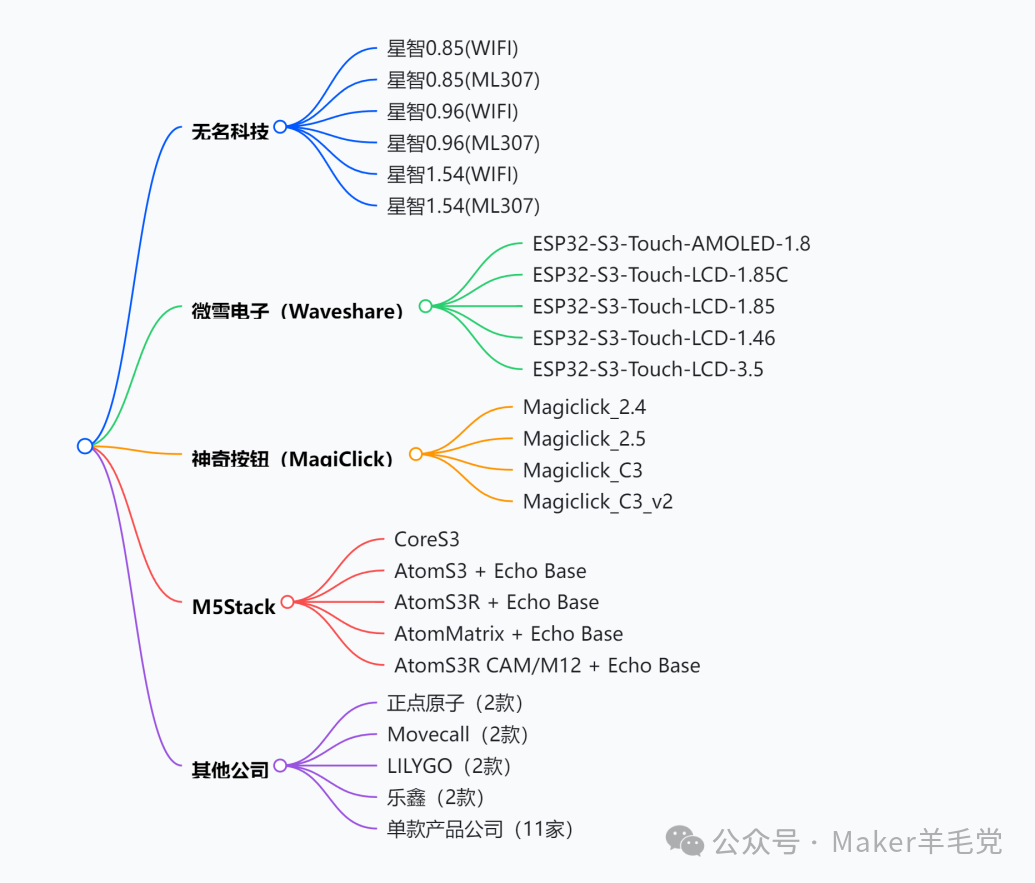
Wuming Technology
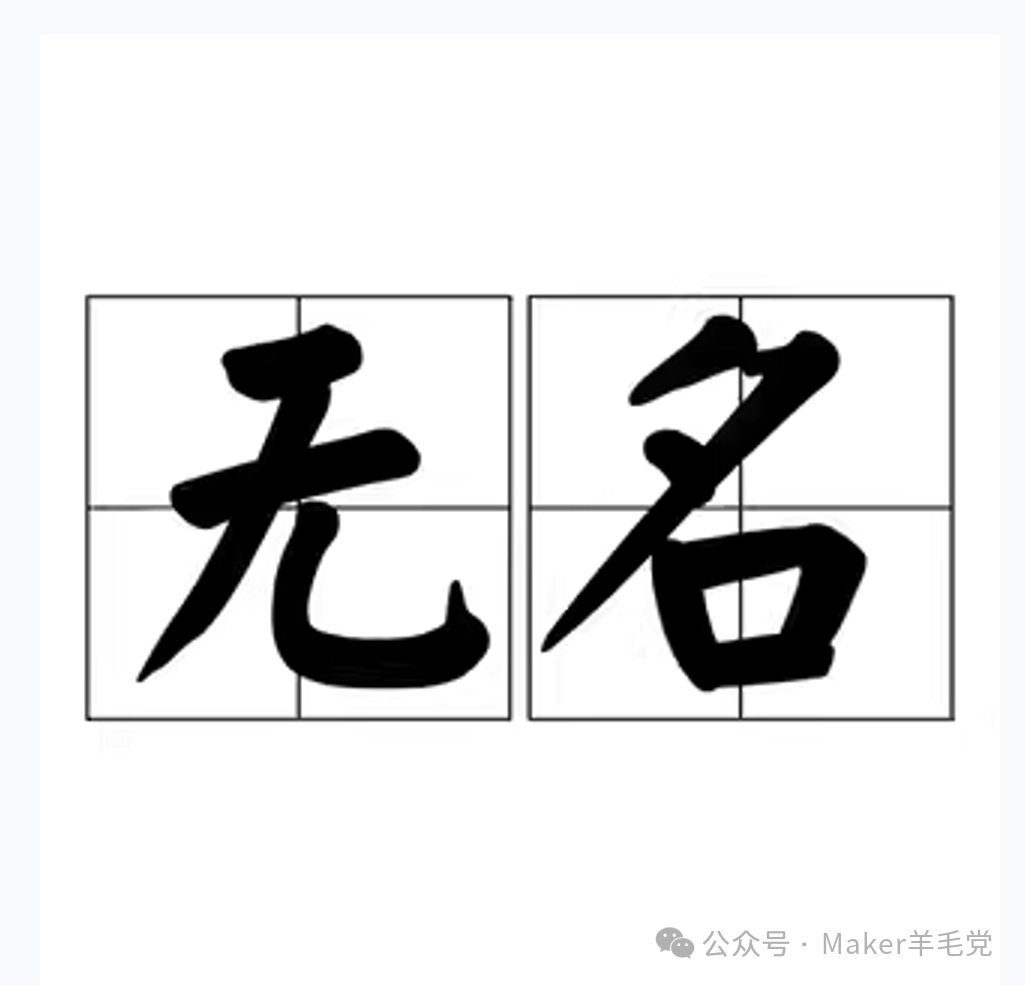
Before the rise of the Xiao Zhi ecosystem, Wuming Technology had low industry recognition, primarily selling cheap DIY development boards. During the Xiao Zhi storm, the products related to Xiao Zhi launched by Wuming Technology, aside from quickly supporting 4G networks, had few highlights overall. However, through its association with Xiao Zhi, Wuming Technology has begun to emerge in the industry, gradually increasing its recognition.
M5Stack
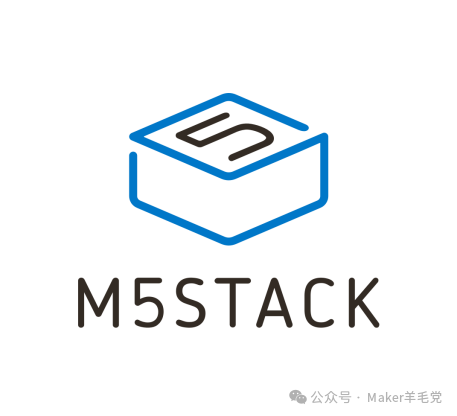
M5Stack is currently a subsidiary of Espressif and has long relied on the Espressif ESP32 chip to develop various types of open-source hardware products, including the Stack series, Stick series, and Atom series, covering multiple application scenarios. It currently has over 300 SKUs, meeting different user needs. For B-end customers in specific scenarios such as Industry 4.0, agriculture, smart cities, and smart retail, it has formed multiple complete industrial IoT solutions, serving many well-known enterprises. At the same time, it optimizes its product line, rapidly iterating new application modules, helping C-end makers and individual developers create functional prototypes at low cost and high efficiency. It has launched a graphical web programming platform “UIFlow” to lower the development threshold, supporting the switching between graphical programs and MicroPython code, although UIFlow and MicroPython have not yet been divided in this event. M5Stack emphasizes community building, with users contributing valuable product cases, open-source code, experience exchanges, and tutorial documents in the community, releasing a new product every Friday afternoon, forming a good user co-creation ecosystem and enhancing user stickiness.
M5Stack officially supports three Xiao Zhi AI products:
1. M5Stack CoreS3: As the current mainstream development board, it supports Xiao Zhi’s offline voice wake-up, multilingual recognition, large model interaction, and other core functions, which can be directly deployed by flashing firmware.
2. AtomS3R + Echo Base: A miniaturized module combination suitable for portable device development, supporting voice interaction and LCD screen display of dialogue content.
3. AtomMatrix + Echo Base: An expansion kit equipped with a matrix LED, which can achieve light effects and voice dialogue linkage through programming, using the ESP32 main control that does not support voice wake-up and full-duplex dialogue.
In addition, M5Stack can use the sensors and stackable modules paired with the original main control to complete the microphone and speaker functions to realize Xiao Zhi’s interaction capabilities, but this has not received official technical support and requires users to build it themselves (not too difficult).

Additionally, new product preview information leaked from M5Stack’s internal communication group indicates that a heavyweight product based on ESP-P4 is about to be released, which will be equipped with a microphone and speaker, making it a natural fit for Xiao Zhi. It is expected to become the first officially certified Xiao Zhi product in the ESP-P4 series. There are also plans for a 4G Xiao Zhi product based on an e-ink screen.
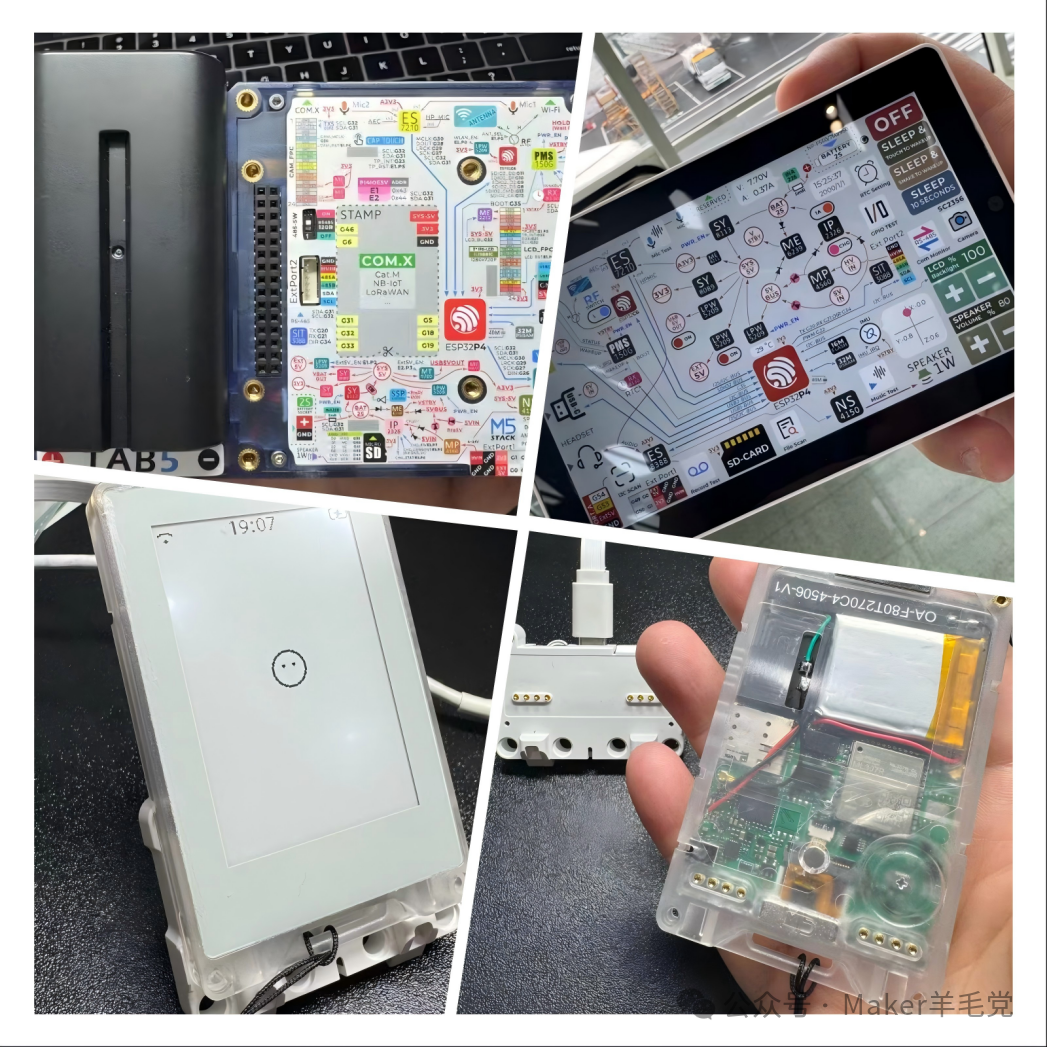
M5Stack new product spy photo
Comments:
In the early stages of the Xiao Zhi storm sweeping the IoT development field, M5Stack’s market response seemed slower than other companies, but in reality, it was conducting a well-organized strategic deployment internally. At that time, the company did not blindly rush to seize market opportunities but adhered to its product development rhythm, steadily advancing its existing product plans. While ensuring continuity in product development, M5Stack actively strengthened its support for the Xiao Zhi ecosystem, integrating it into its product system.
Unlike some companies that purely chase market trends, M5Stack has always focused on product aesthetics and quality as core competitive directions. In industrial design, M5Stack’s products are exquisitely compact, with clever modular designs that facilitate assembly and expansion for developers while possessing unique visual recognition; in quality control, the company strictly follows high-standard production processes, striving for excellence in every aspect from component selection to finished product testing, ensuring product stability and durability. This long-term perspective development strategy makes support for the Xiao Zhi ecosystem a “finishing touch” to enhance its product value rather than a core survival element.
Market performance is an important standard for evaluating the effectiveness of strategies. Once M5Stack’s products supporting Xiao Zhi were launched, they quickly stood out in the market due to their solid quality and unique functions. On second-hand trading platforms like Xianyu, these products once experienced a premium situation. Although prices have adjusted as market enthusiasm gradually recedes, M5Stack’s products still maintain a high value retention rate compared to other similar ESP32 development board products, fully demonstrating their market recognition and brand value.
Suggestions:
Strengthen domestic market development efforts: Currently, M5Stack’s influence in the domestic market mainly relies on the enthusiastic grassroots community for spontaneous dissemination and organization of related activities. While this method can gather a loyal user base, it lacks systematic and scalable effects. The company should include the domestic market in its core strategic planning and increase marketing investment. Rewards should be given to fans who propose excellent product improvement suggestions, actively promote the brand, such as product giveaways, priority experiences of new products, and participation in product internal testing; hold fan creative competitions to encourage fans to innovate based on M5Stack products and showcase and promote outstanding works, enhancing fans’ sense of belonging and brand loyalty.
Waveshare

Waveshare is an innovative technology company focused on open-source hardware compatibility and modular design, providing cost-effective solutions for IoT, industrial automation, and education. Its features include a full-stack product ecosystem: covering e-paper displays, sensors, embedded development boards (compatible with Raspberry Pi/Arduino), and robotic components, forming a complete chain from hardware to application scenarios, with its most well-known products being Raspberry Pi screen products. After 2024 (post-pandemic), Waveshare’s product growth rate has significantly increased, sometimes launching several new products on its official website in a week (coincidentally aligned with another company’s pace), and has enhanced product appearance design, offering products with and without enclosures in addition to development boards.
According to information from Xiao Zhi’s code repository, Waveshare has four products supporting the Xiao Zhi AI chatbot: ESP32-S3-Touch-AMOLED-1.8, ESP32-S3-Touch-LCD-1.85, ESP32-S3-Touch-LCD-1.85C, ESP32-S3-Touch-LCD-1.46, ESP32-S3-Touch-LCD-3.5, and others that are claimed to support Xiao Zhi on their official website, with several standout products listed below.

The ESP32-S3-Touch-AMOLED-1.75-B development board launched by Waveshare is priced at about 200 yuan, comes with an enclosure, and features a 1.75-inch 466×466 pixel AMOLED touchscreen, using a QSPI interface, with an internal CO5300 display driver and CST9217 capacitive touch chip. It is equipped with an ESP32-S3R8 dual-core processor, supporting dual digital microphone arrays, six-axis sensors, RTC chips, etc. Compared to traditional LCD screens, the AMOLED screen has more precise light control capabilities, rich colors, detailed visuals, wide viewing angles, and features low power consumption and thinness, making it suitable for watch dials.
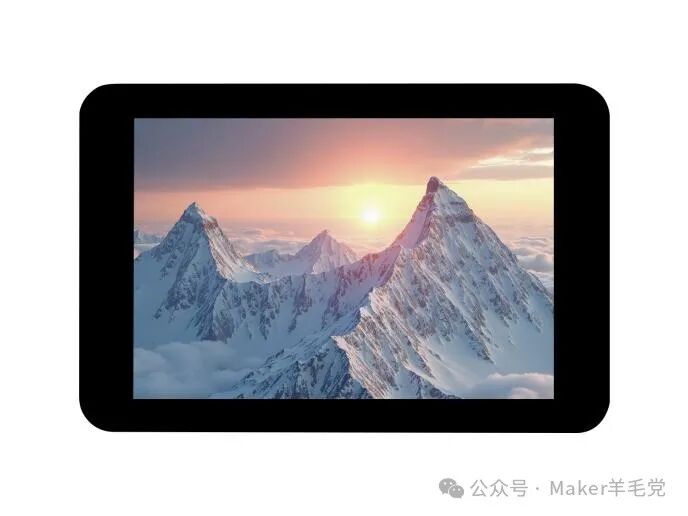
The ESP32-S3-Touch-LCD-3.5 development board from Waveshare is priced at about 150 yuan, available in versions with and without enclosures. It features an ESP32-S3R8 dual-core processor, a 3.5-inch capacitive touch HD IPS screen with a resolution of 320×480, displaying 262K colors, with an internal ST7796 driver chip, communicating via SPI interface, and an FT6336 capacitive touch chip. It has various onboard peripherals, such as six-axis sensors, RTC chips, etc., and a camera interface supporting mainstream cameras.

The ESP32-S3-Touch-LCD-1.85C-BOX development board from Waveshare is priced at about 200 yuan, comes with a speaker, and features a 1.85-inch 360×360 resolution 262K color LCD screen with touch support. The display screen is a 1.85-inch LCD screen with a resolution of 360×360, displaying 262K colors, using an ST77916 driver chip, communicating via QSPI interface and CST816 capacitive touch chip, with an onboard audio decoding chip PCM5101, microphone, RTC clock chip PCF85063, Micro SD card slot, and a battery charging management chip, connecting to a high-power speaker through the speaker interface, supporting high-quality audio processing.
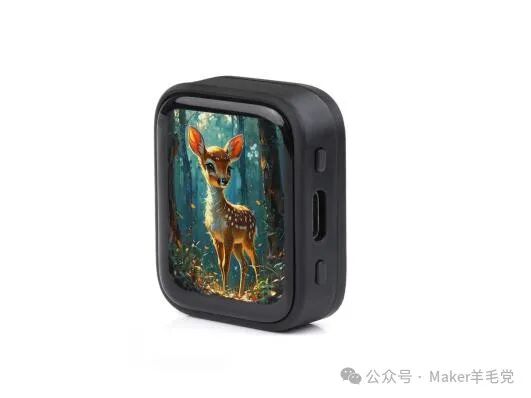
The ESP32-S3-Touch-AMOLED-1.8 development board from Waveshare is available in versions with and without a lithium battery. It features a 1.8-inch capacitive touch HD AMOLED screen with a resolution of 368×448, displaying 16.7 million colors, with a brightness of 350cd/㎡, a contrast ratio of 100000:1, and an internal SH8601 display driver chip, communicating via QSPI interface, with various onboard peripherals such as six-axis sensors, RTC chips, Micro SD card slots, etc.
Comments:In the wave of technological applications and product development related to the Xiao Zhi ecosystem, Waveshare has stood out due to its deep technical accumulation and efficient response mechanism. Relying on its professional team that has been deeply involved in the development of supporting hardware for embedded systems for many years, Waveshare has demonstrated strong market sensitivity. At the early stage of the Xiao Zhi ecosystem’s demand emergence, it quickly integrated technical resources and launched multiple highly competitive products in a short time, becoming a focal point in the industry.
Waveshare’s product matrix advantage is significant. On one hand, its product line specifications are rich and diverse, fully leveraging its core advantages in hardware device screen production. Each product features high-definition resolution screens that also integrate touch functionality, meeting developers’ needs across different scenarios, from low-power small-size LCD screens to high-refresh-rate large-size touch screens; on the other hand, in the selection of audio decoding solutions, Waveshare also showcases differentiated design thinking, providing diverse technical reference examples for the open-source community.
Among many products, the Xiao Zhi devices equipped with custom speaker cavities are particularly eye-catching. Compared to similar finished products on the market (excluding DIY assembled products), these devices achieve stronger volume performance and high-quality sound output due to their excellent acoustic structure design, becoming a typical representative of Waveshare’s product technical strength. This extreme pursuit of functionality in specific segments further solidifies its leading position in the Xiao Zhi ecosystem hardware market.
Suggestions:
1. Strengthen quality control systems to ensure product stability: As the speed of product iteration and new launches accelerates, Waveshare needs to focus on improving its quality control system. For some products with issues such as flying wire designs and system crashes, it is recommended to optimize product design processes, enhance the reliability verification of component selection, introduce stricter aging tests and stress tests, and establish a rapid response after-sales feedback mechanism to promptly collect quality issues during user use, quickly iterating and optimizing through firmware upgrades and hardware improvements to ensure long-term product quality and brand reputation.
2. Enhance product extensibility to increase user stickiness: Given that the current user scenarios for Xiao Zhi chatbots mainly focus on simple experiences and testing, without forming deep reliance, Waveshare should focus on enhancing the extensibility of product functions. This can be achieved by reserving standardized interfaces (such as GPIO, SPI, I²C, etc.) and modular designs to support users in flexibly adding sensors, communication modules, and other external devices based on actual needs; additionally, it can build application scenario solutions around the Xiao Zhi ecosystem, such as smart home control and educational programming kits, transforming single-function devices into comprehensive application platforms with practical value, reducing the risk of product idleness and increasing users’ willingness to use them long-term.
Other Brand Enterprises
In the development wave of the Xiao Zhi chatbot ecosystem, some embedded system manufacturers carry multiple development boards supporting Xiao Zhi’s capabilities, but due to their cautious attitude towards the market prospects of the Xiao Zhi ecosystem, their overall participation enthusiasm is limited. However, thanks to the active promotion of many enthusiastic netizens in the open-source community, these manufacturers can still share the dividends brought by the prosperity of the Xiao Zhi ecosystem. Many tech enthusiasts voluntarily take on the adaptation work, actively integrating these manufacturers’ development boards with the Xiao Zhi system, submitting adaptation projects to Xiao Zhi’s official team, and continuously following up on optimizations, improving subsequent software upgrades and functional iterations. This grassroots power has enabled these products to integrate into the Xiao Zhi ecosystem even with low manufacturer participation.
Independent Developers
Independent developers and small maker groups struggle to survive in the cracks of second-hand trading platforms like Xianyu. Most of them lack professional technical teams and stable supply chain support, relying on personal interests and scattered resources for product development. Among them, ordinary makers mainly focus on low-cost modification projects, simply expanding the functions of consumer electronics like Bluetooth speakers or assembling and selling homemade simple development boards. Although these products lack deep optimization in design and their stability and compatibility cannot compete with large manufacturers’ products, they still attract some budget-conscious electronics enthusiasts due to their low prices and personalized functions. A few technically versatile maker leaders attempt to launch more technically sophisticated innovative works, often showcasing their products’ cool features through social media and tech forums, attracting temporary attention and even sparking trending topics for a period.
However, constrained by funding shortages, production difficulties, and market competition pressures, the innovative achievements of these “wild Iron Men” often resemble fleeting fireworks. The lack of long-term technical iteration and market operation makes it difficult for products to form sustained user stickiness. With the emergence of new trends, their works quickly fade from the market, forcing them to re-engage in the next round of uncertain creation and survival.
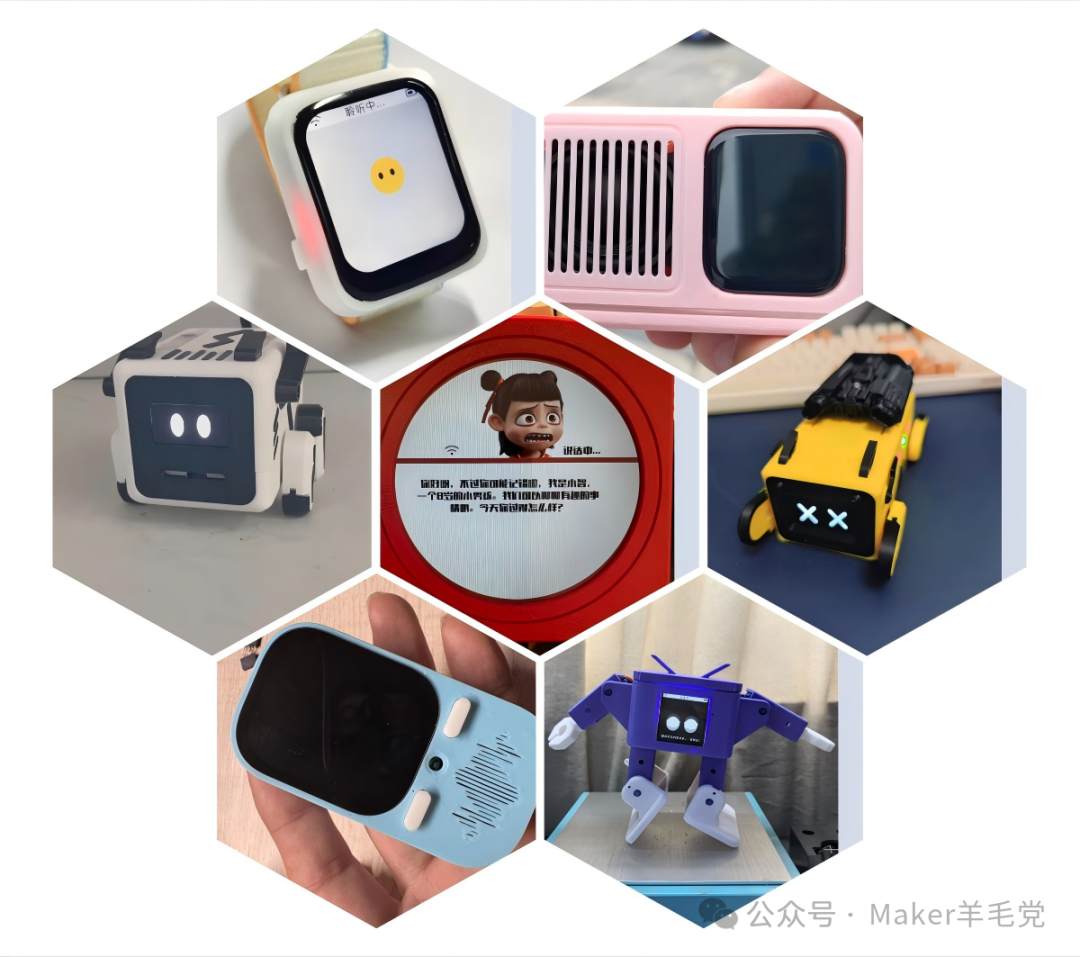
6. Suggestions for Developers
In the “AI hardware equity” movement, the key to rapid success for tech companies lies in leveraging their technical reserves to create innovative products. In the short term, they need to quickly develop prototype products that combine functional features and exquisite appearances based on their technical advantages to seize market opportunities; in the medium term, they should optimize product functions based on market feedback, strengthen core technologies, balance performance and costs, and build technical barriers; in the long term, they should actively expand product ecosystems, collaborate with multiple parties, continuously invest in R&D, regularly update and iterate, add additional functions, meet users’ dynamic needs, and consolidate market advantages. This revolution of co-creation between geeks and the public not only sees ordinary developers contributing knowledge but also facing numerous challenges. Even all-round developers may have shortcomings in certain areas:
1. Product appearance is simplistic: Most ordinary developers lack professional knowledge and skills in appearance design, making it difficult to create products that are both aesthetically pleasing and practical. They often overlook aspects such as user grip and operational convenience. For example, unreasonable button layouts may require users to frequently adjust their hand positions during operation, affecting the user experience. This results in products lacking attractiveness in appearance, making it hard to stand out in the market. For instance, issues such as simplistic designs, rigid shapes, and unreasonable color schemes may arise.
2. Insufficient software robustness: Ordinary developers often focus on the basic functionality of hardware but lack the ability to deeply optimize hardware performance. They may struggle with reliability design and optimization for hardware products, failing to fully consider various extreme situations and stability issues during long-term use. This may lead to products being prone to failures during actual use, affecting normal user operation.
3. Lack of their own sales platform: Ordinary developers have limited resources, which makes them face many difficulties during development. To reduce development difficulty, they often use mainstream audio solutions, but due to the high usage of these mature solutions, prices have become inflated. Randomly choosing expensive components or adopting unnecessarily complex design solutions leads to high product costs, losing market competitiveness. Without their own mature sales methods and after-sales teams, they have weak risk resistance when facing market risks and technical challenges.
4. Slow response to market changes: They often lack market insight and cannot timely and accurately grasp changes in market trends and user needs. Since building the Xiao Zhi chatbot has almost no barriers, players with moderate programming skills can build it themselves. Ordinary developers often focus their energy on implementing software and hardware functions, neglecting the real market situation, leading to their developed products being out of sync with market demands and unable to meet user expectations. Ultimately, how to sell the produced products becomes their biggest problem, even turning into a painful memory.

Based on the above issues, the following suggestions are made:
1. Actively embrace the open-source ecosystem: Proactively participate in open-source projects related to Xiao Zhi AI, deeply study its core code using platforms like GitHub, understand its “terminal perception + cloud intelligence” hybrid architecture and the working principles of the emotional computing engine, and innovate based on the shoulders of predecessors. Maintain close communication with developers in the open-source community, join relevant developer communities, such as Xiao Zhi’s official QQ group and grassroots learning and mutual aid WeChat groups, actively share experiences and insights, and gain inspiration and solutions from others to jointly promote project development.
2. Continuous learning and improvement: Learn about the Espressif ESP32 series chips, including their hardware architecture, development frameworks (such as ESP-IDF), and how they work in conjunction with other hardware modules, fully leveraging the chip’s performance to achieve more efficient and stable functional development. Due to the difficulty in setting up the programming environment for Espressif’s IDF framework, the steep learning curve has led many developers to only scratch the surface and turn to the more convenient and user-friendly Arduino implementation. Currently, over 60 products supporting Xiao Zhi are integrated into the Xiao Zhi GitHub resources, with the number expected to increase to hundreds, including excellent code submitted by professionals, forming a treasure trove of IDF programming knowledge. Even if there is no intention to participate in Xiao Zhi product development and profit-making activities, this learning opportunity can help overcome the challenges of the IDF programming framework and elevate programming skills to a new level.
3. Explore differentiated routes: Always focus on user experience during the development process, designing simple, easy-to-use, and naturally interactive product interfaces and operational processes based on user needs, habits, and feelings. Fully leverage personal advantages, such as using one’s understanding and research foundation of LVGL to develop more interesting dialogue interaction interfaces, deeply learn about Xiao Zhi’s functional modules, and strengthen the application technology of Xiao Zhi in IoT, maximizing the advantages and computing power of the backend large language model.
4. Explore business models and cooperation opportunities: For ordinary developers, it is challenging to cover all elements of the industrial chain, requiring external forces to achieve success. Consider how to transform development achievements into commercial value, explore suitable business models, and seek cooperation opportunities with upstream and downstream enterprises in the industrial chain, establishing partnerships with hardware manufacturers, cloud service providers, application developers, etc., to jointly build a more complete ecosystem and achieve mutual benefits.
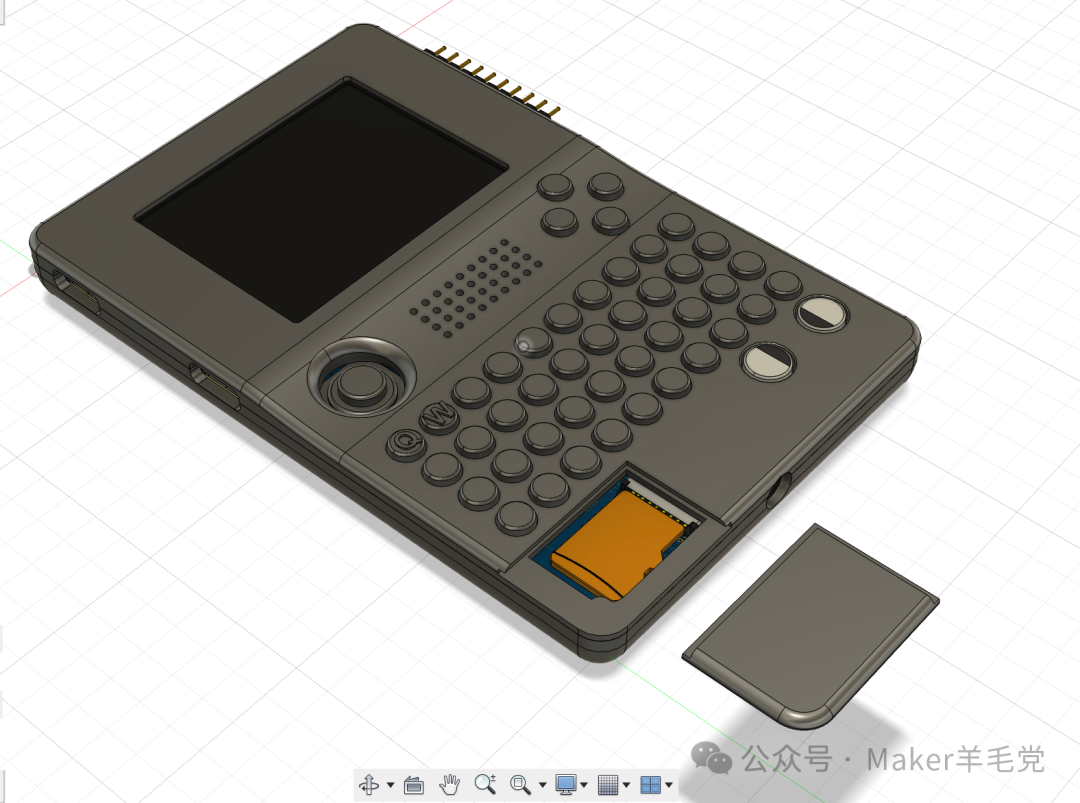
(Wool Party Leader – Hua Ge —- Work)
7. Suggestions for Xia Ge
Boldly, I would also like to offer some suggestions to Xia Ge. Regardless of the future outcome, Xia Ge has pioneered the integration of large language models with embedded systems, making him a hall-of-fame figure. However, as times continue to advance, it remains to be seen how long the heat of Xiao Zhi will last. It is suggested that Xia Ge continue to explore new application scenarios based on the existing functions and architecture of Xiao Zhi AI, combined with practical needs in life. For example, develop customized solutions for specific industries or groups, such as creating more efficient intelligent customer service terminals or IoT control solutions for small and medium enterprises. Additionally, Xia Ge may already be advancing related work and could consider applying for special funding support from the Shenzhen Science and Technology Bureau to purchase more acceleration cards, making Xiao Zhi’s dialogue process smoother.
8. Future Challenges: From Phenomenon to Sustainability
In this “AI equity storm” triggered by hundred-yuan hardware, Xiao Zhi AI and Espressif Technology have joined forces to break down the high walls of technology with the power of open source, bringing AI into thousands of households. From geek toys to universal creative tools, from cold machines to warm interactive partners, Xiao Zhi AI has not only changed the paradigm of hardware development but also made emotional computing a reality, allowing everyone to feel the warmth of technology.
However, this revolution is not the end but a new beginning. The future path of Xiao Zhi AI is filled with opportunities and challenges. The transformation from “toy” to “tool” requires not only technological upgrades but also ecological improvements. The vigorous development of the open-source ecosystem injects continuous innovative power into Xiao Zhi AI. However, as the scale of the ecosystem expands, how to establish fair and transparent open-source agreements, balance intellectual property protection with technology sharing, and avoid internal friction caused by disorderly competition will be key to whether this revolution can be sustained. This requires not only technological wisdom but also governance wisdom.
The rise of Xiao Zhi AI is a great victory for technological democratization, allowing technology to shed its aloof exterior and return to its essence of serving humanity. Every ordinary person can become a promoter of technological progress, which may be the most profound significance of “AI hardware equity.” In the future, Xiao Zhi AI may face market fluctuations and technological iterations, but as long as it maintains an open mindset, a spirit of continuous innovation, and a deep insight into human needs, this transformation triggered by hundred-yuan hardware will surely evolve from a technological frenzy to a practical tool for empowering social development, allowing technology to truly serve everyone.
